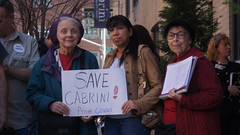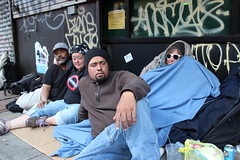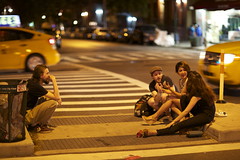Last week, Community Board 3 approved 19 pages worth of funding requests that it hopes will eventually win the support of the City Council and Mayor Bloomberg.
The document is an important one. “The district needs statement kicks off the city’s budget process,” board member David Crane told The Local.
Outlining priorities in the areas of education, nightlife enforcement, housing, and public health, the sprawling call to action now goes to the Office of City Planning, which distributes relevant sections to the appropriate agencies. From there, dialogue and negotiations between the board and the city begin, culminating in a more boiled-down statement of budget requests submitted to the city in October.
City Council Speaker Rosie Mendez said district needs statements, and community boards in general, play a “significant role” in the formation of each year’s budget. “Past district needs statements have been the basis for a number expense and capital grants as well as collaborative programs,” she said.
The statement doesn’t change much from year to year, but this year the board added language to the Housing and Land Use section that trumpets a need to “slow the growth of gentrification and to ensure that long-term residents can remain in decent affordable housing.”
The section on health also got a major reworking, starting with a request for asthma prevention funding. In the city’s 2010 Department of Health Community Survey, the district ranked in the top third of those reporting at least one asthma attack in the past year.
“We tried to focus on, ‘What is the need?’ and we tried to back it up with statistics,” said Mr. Crane.
Susan Stetzer, the board’s district manager, also noted an increased emphasis on facts and figures. “I think there was an excellent focus this year on gathering statistics and having supporting documentation so we can be taken seriously,” she said. “When you say, ‘50 percent of the people in C.B. 3 are on public assistance,’ that is a powerful statistic that shows that we need help and support for our community.”
The document, which can be viewed in its entirety here, also warns against continued budget cuts. “In the past year human service issues have been proposed for dire cuts that would have hurt us terribly,” said Ms. Stetzer. “We have to be vigilant that that doesn’t happen again.”
Here, pulled from the statement, is what Community Board 3 is asking the city to do this year.
Economic Development –
- Implement “programs and solutions to attract a diversity of retail businesses and to allow for affordable storefront rents.”
Housing and Land Use –
- “Increase the stock of the subsidized affordable housing.”
- “Preserve existing public housing; augment the extremely tight NYCHA budget.” End “the current practice of requiring NYCHA to pay for police services and of charging Payments In Lieu Of Taxes (PILOT).”
- “Reverse the trend of deregulating rents.”
- “Upgrade enforcement of housing and building codes and fund community-based housing organizations.”
- Revise the 421-a tax abatement program by doing the following: “1) Eliminate the use of negotiable certificates; 2) Mandate that only 30% of on-site affordable housing satisfies the abatement requirements; and 3) Mandate that developers taking advantage of both 421-a tax abatements and inclusionary zoning bonuses should allocate 40% of the on-site units for affordable housing.”
- “Provide matching grants to low-income HDFCs to encourage energy upgrades that will reduce energy costs for low-income buildings.”
Nightlife and Licensing
- “Implement more effective policies governing enforcement, and provide more staffing and resources to its enforcement agencies. This includes increasing police staffing and returning specialized units such as cabaret units to all police precincts, in order to address the growing noise, congestion and other issues resulting from the growth of nighttime businesses.”
- “Create legislation that would restrict sidewalk cafés in areas whose use cannot accommodate them”
- “Create legislation to differentiate between businesses seeking to obtain permits to extend food service to sidewalk seating and those seeking to extend their bar space outdoors. Businesses should also be required to create waiting areas within their sidewalk café boundaries to ensure clear sidewalks for pedestrians where cafes operate.”
Youth
- “Provid[e] as many youth as possible with job opportunities”
- Increase “subsidized child care to support low-income working parents and to provide educational opportunities for their children.”
- “Maintain and expand programs to help these young people make this transition [out of foster care]… [they] should be provided with a set amount of funding that they could access for a variety of needs, including school, housing, health, etc.”
Education
- “Improve facilities to include elevators/barrier-free buildings, gyms, libraries, science labs and facilities for art, dance, movement, music, academic intervention and support therapies.”
- “Decreas[e] class sizes, especially in our early grades where small class size is of such great importance for improved long-term academic outcomes, and closing the achievement gap.”
- “Expand and improv[e] Middle School choices, especially for high performing students in the district.”
- “Increas[e] Dual Language programs, especially Spanish and Mandarin, at the elementary and stand-alone middle school levels.”
- Implement “supportive services to address the emotional and adjustment issues of some students who are raised abroad and move to the United States when they are school-age to live with parents they hardly know.”
- Collect “data to determine the future need for additional school facilities as colocations and new housing starts/housing development continue on the Lower East Side, especially related to SPURA.”
- Open “a shared District 1 and District 2 Pre-K to 8th grade school to be built as part of the Seward Park Mixed Use Project Site.”
Health
- Implement “culturally appropriate ongoing and targeted efforts aimed at helping our residents manage their weight to help prevent the onset of diabetes.”
- “Expand and enhance outreach to help residents stop smoking.”
- “A more comprehensive public health effort is needed that seeks to address the interaction of multiple factors to reduce the incidence of alcohol-related problems.”
- Institute “culturally appropriate awareness and education efforts targeted at promoting correct and consistent condom use during anal intercourse to prevent the spread of HIV among men who have sex with men.”
- “Access to needle exchange programs, and funding is needed to enhance existing programs and to develop better linkages between programs in order to reduce fragmentation of service delivery.”
- Provide “culturally competent mental health services for residents, particularly for the Chinese and Latino populations.”
- Increase the number of mental health “providers with appropriate training to meet community needs, particularly for our under-served populations.”
- Increase “funding to reduce known asthma triggers, such as poor housing conditions and rodent and insect infestation, as well as to increase education and awareness of how to reduce these triggers and thereby reduce the incidence of asthma.”
- “Increas[e] funding for community-based health providers that serve low- and moderate-income residents with and without insurance.”
Seniors
- Continue and strengthen “culturally and linguistically appropriate supports and services that allow senior citizens to remain in their homes and communities”
- “Funding for existing programs [to help seniors age safely at home] should be maintained while opportunities to expand the [Naturally Occurring Retirement Communities (“NORC”)] programs in our community should be explored.”
Homeless Services
- “Conduct outreach that can focus on all homeless individuals instead of the current policy of outreaching to only chronically homeless individuals.”
Police Department
- Increase the number of “dedicated cabaret units… as well as supplementary police staffing on weekends.”
- “Expand the force of Traffic Enforcement Agent (TEAs) deployed by NYPD’s Lower Manhattan traffic command”
- “Enforc[e] traffic laws regarding dangerous and illegal cyclist behavior.”
Sanitation
- “Complete replacement of baskets with rat proof baskets as well as increased cleaning and pick up.”
- “Enforcement is needed for garbage storage and removal by street vendors. Policy concerning vendors must be reviewed and modified so that vendors are able to operate consistent with regulations.”
Public Transportation
- “Improve the environment for public transportation within CB 3 by taking strong, creative measures to reduce traffic congestion.”
Private Bus and Van Services
- Implement “a bus storage plan to accommodate the bus layover needs of various types of coach buses and vans that provide private services”
- Implement “a realistic bus storage plan to avoid unplanned dispersal of coach buses in our neighborhoods… limit the number of bus companies and buses allowed to operate in the area.”
- Restrict and designate “locations for loading and unloading.”
Illegal Parking
- “Enforcement is needed as well as a plan to allow these [illegally parked produce wholesalers and private limousines] to comply.”
Sidewalk and Road Surface Conditions
- “Curb cuts that do not meet smoothly with the street bed should be repaired and missing curb cuts should be installed.”
Pedestrian Safety near Bridges
- “Assign a crossing guard, especially at Clinton and Delancey Street, given the number of nearby schools. Similar safety improvements are needed on other traffic corridors, such as Essex and Canal Street.”
Bicycle Facilities
- “Continue to include reduction of pedestrian-cyclist conflicts as a design consideration of all bicycle facilities”
- “Augment [the] CityRacks Program, which allows the public to request bicycle racks one at a time, with planning efforts to systemically identify areas with a need for more bicycle parking and suitable locations for installation”
Environment
- “Have an enforcement mechanism that will focus and enforce idling regulations.”
Parks/Recreation/ Cultural Affairs/ Landmarks
- Re-examine “Parks Department policies that restrict the use of parks and play areas during daytime hours.”
- “Consider transferring [community gardens] to local community land trust organizations that can maintain the locations as permanent open community space.”
- “Allow the public to reclaim use of the Parks buildings (particularly those within Sara D. Roosevelt Park) by redistributing storage more fairly to outside areas and programming public use of those buildings”
- Hire “more full-time experienced extermination and staff to maintain and clean the parks”
- “Increase transparency in the permitting process, as well as revisit public procedures for reviewing and re-approving light usage for night use of fields.”
- “Continue to maintain this fair distribution of park permitting time for local groups and to upgrade its computer system to improve its permitting process.”
- “Ensure review from the NYPD and the Community Board for larger events”
- Increase the number of “toilets in CB 3 parks and playgrounds.”
- “Expand [the Landmark Commission’s] survey of ideal sites for landmark preservation similar to the one it has already done for the East Village. Such landmark studies should include Chinatown and the Lower East Side.”
New York City Libraries
- “Preserv[e] library openings to six days a week and restor[e] full operating hours”
- “Expand funding for expansion of collections, automation, staffing, and programming”
- Implement “more youth programming in libraries as a way to engage youth in meaningful activities”
Waterfront
- “Reclaim the waterfront for public use, keeping in mind the primarily residential nature of the adjacent community.”
- “The shed area of Pier 42 should be removed and allow for community revisioning to move forward. We strongly urge and expect that the relevant City agencies will raise the necessary funding, fast track, and complete this improvement and stabilization, within the 2014 timeframe, so that Pier 42 will never be lost as a crucial amenity to this community.”
Arts & Cultural Affairs Task Force
- “Include commercial and nonprofit arts venues and organizations in their economic planning and development policies”
- “Work in public-private partnerships to provide reasonably priced electricity and water to community gardens so that they become true community centers for culture.”
- “Expan[d] subsidized rehearsal space for music, dance, theater, and performance art”
- Insure that “financial incentive for outreach be available to local venues to promote partnerships with local community-based organizations and use of space to increase public and resident benefit.”
- Build “coalitions among arts and cultural organizations, other not-for-profit organizations, community and senior centers, elected officials, and government agencies in order to identify the conditions ideal for artists and arts organizations and prevent the instability or loss of this the community.”






